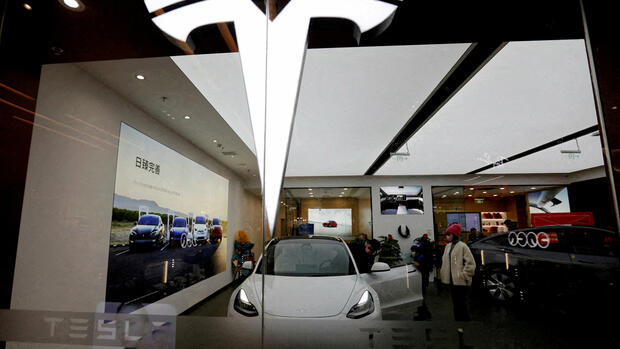new York The electric car manufacturer Tesla is feeling the consequences of the price war started by CEO Elon Musk. Tesla sales jumped 24 percent to $23.3 billion in the first quarter of 2023. The Group also achieved a new record with 422,875 deliveries.
In return, however, the margins are falling, as Tesla announced on Wednesday evening. Consolidated profit fell compared to the same quarter last year by 24 percent to 2.5 billion dollars (2.3 billion euros). So Tesla delivered more vehicles, but earned less because of the discounts.
Analysts’ expectations were undercut. On average, they had expected even higher sales and deliveries. The stock fell by almost 6 percent in after-hours trading.
Musk had boosted sales with high discounts, and there have already been several rounds of price cuts in the US this year. Profitability suffers as a result, even if Tesla has high profit margins compared to the industry.
Musk justifies the 14 to 25 percent lower prices in the USA by wanting to make e-cars affordable for the general public. According to his interpretation, there is no lack of demand.
>> Also interesting: Why Tesla is suddenly shying away from silicon carbide
In fact, deliveries in early 2023 increased by just four percent compared to the previous quarter. Almost 18,000 vehicles produced did not initially find a buyer. As a result, Tesla struggled with high inventories – an unusual situation for the group, which had previously been noticed by unusually long waiting times for its new cars.
“We believe that higher volume and a larger fleet is the right choice, as opposed to lower volume and higher margin,” Musk said at Wednesday night’s analyst call. Pre-orders are now back above production capacity, Musk said, and additional revenue will be generated from software sales.
declining margins
Observers expect further price reductions. Tesla has little choice but to enter a price war, analysts believe. “Tesla has cut prices around the world to maintain its lead over traditional US rivals like Ford while keeping up with Chinese automakers like BYD and SAIC,” said Insider Intelligence analyst Jeremy Goldman.
Alyssa Altman of consulting firm Publicis Sapient believes Tesla can afford the price cuts. The group produces efficiently and has the clear advantage of already being fully electric: “Even if profit margins come under pressure, Tesla will find a way to grow profitably.”
Tesla’s operating margin fell from over 19 percent in early 2022 to just over 11 percent now. At Ford it was around four percent in 2022, according to the analysis company FactSet, and at General Motors it was a good six percent.
>> Read also: Car manufacturers face the end of “picture book profits”
Tesla’s profitability remains exceptionally high for the auto industry. According to Pedro Pacheco from the Gartner consulting firm, this shows that the group “still has a certain amount of leeway to use aggressive pricing as a commercial weapon in the future.” However, according to Pacheco, production capacities can no longer be fully utilized without discounts. And the margin development is pointing downwards.
Sophie Lund-Yates from the financial house Hargreaves Lansdown sees the pressure on the margins in connection with the still very high valuation as the biggest risk factor. “It is unclear where the margins will level off if the price cuts continue. Sacrificing margin to boost sales is often the right move, but only if done judiciously and not over long periods of time.” Lund-Yates warns that otherwise the brand will be damaged.
Worry about upper limit
The question is how long investors will support Musk’s strategy of exchanging profit for sales. Tesla’s share price had fallen by almost two-thirds in 2022. Since the turn of the year it has risen by almost 50 percent.
Buyers of the expensive autopilot software “Full Self-Driving Beta” should also be concerned with the question of how Musk will explain his strategic shift in autonomous driving. As the Handelsblatt reported in March, Tesla is planning to use radar systems again in new models – contradicting Musk’s earlier promises.
The CEO did not comment on this swing on Wednesday evening. Instead, Musk reiterated the cunning goal of being able to make fully autonomous cars possible this year.
Wall Street has been concerned for some time that Tesla’s traction is waning after years of tumultuous growth. Recent price cuts had fueled suspicions that demand for Tesla cars could wane and the long-hyped company could become just one carmaker among many.
The current model generation is showing its age, and hopefuls like the Cybertruck pick-up have been a long time coming. It should not be delivered on a larger scale until 2024, as Musk had explained. Meanwhile, the competition is not sleeping: classic car manufacturers such as Ford and GM are celebrating delivery records with all-electric versions of their pick-up trucks, which are popular in the USA.
Tesla plans to deliver around 1.8 million vehicles in 2023. The group is also planning a new factory in northern Mexico and a battery factory in Shanghai. According to Tesla’s CFO, investments of almost $150 billion are possible in the coming years.
In 2022, the group had earned more than ever before in a fiscal year and increased profits by 128 percent to $ 12.6 billion. However, Tesla missed its 50 percent growth target.
Musk’s increasingly unpredictable leadership style and the negative headlines surrounding the takeover of the short message service Twitter also had a negative effect.
More: The Chinese are attacking the electric car market with these models
